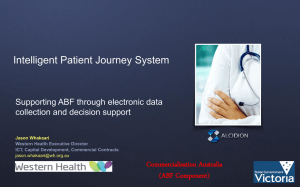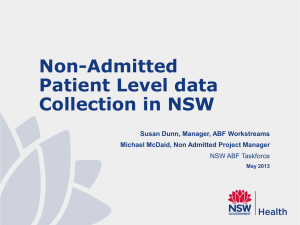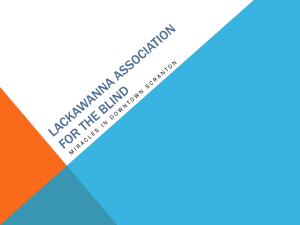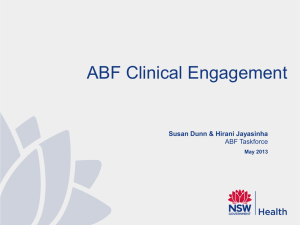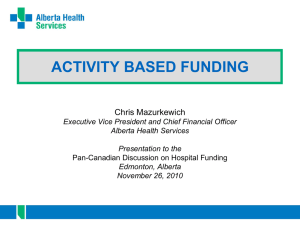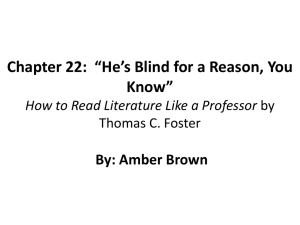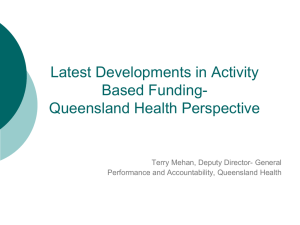Migration Assurance (NBN) – August 2015
advertisement
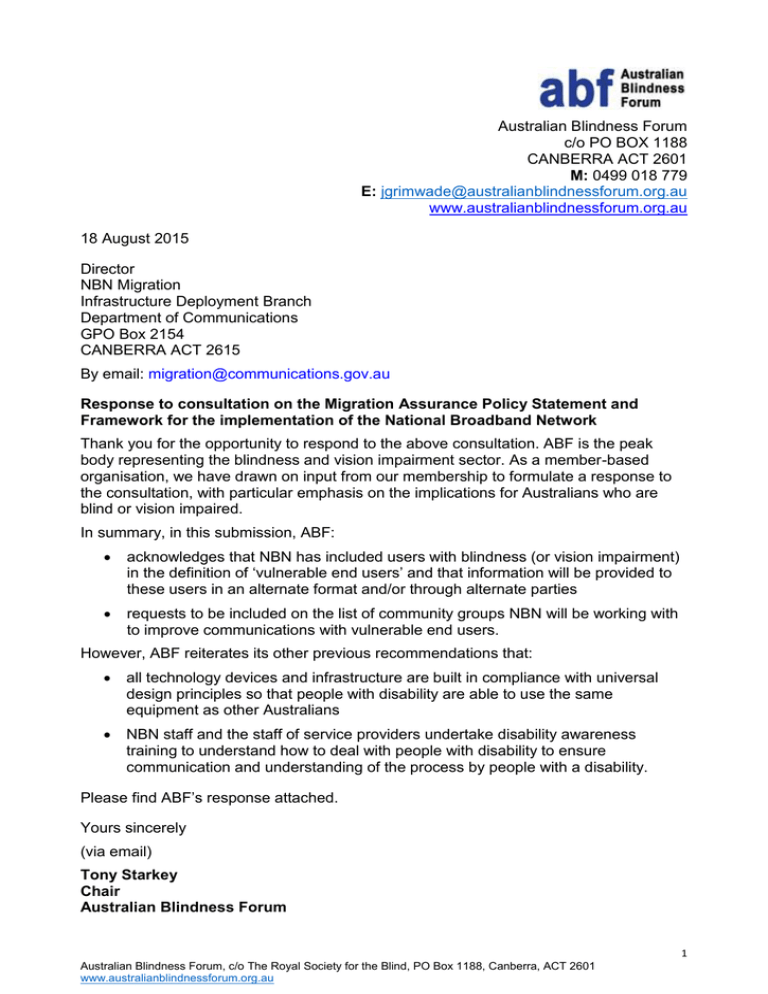
Australian Blindness Forum c/o PO BOX 1188 CANBERRA ACT 2601 M: 0499 018 779 E: jgrimwade@australianblindnessforum.org.au www.australianblindnessforum.org.au 18 August 2015 Director NBN Migration Infrastructure Deployment Branch Department of Communications GPO Box 2154 CANBERRA ACT 2615 By email: migration@communications.gov.au Response to consultation on the Migration Assurance Policy Statement and Framework for the implementation of the National Broadband Network Thank you for the opportunity to respond to the above consultation. ABF is the peak body representing the blindness and vision impairment sector. As a member-based organisation, we have drawn on input from our membership to formulate a response to the consultation, with particular emphasis on the implications for Australians who are blind or vision impaired. In summary, in this submission, ABF: acknowledges that NBN has included users with blindness (or vision impairment) in the definition of ‘vulnerable end users’ and that information will be provided to these users in an alternate format and/or through alternate parties requests to be included on the list of community groups NBN will be working with to improve communications with vulnerable end users. However, ABF reiterates its other previous recommendations that: all technology devices and infrastructure are built in compliance with universal design principles so that people with disability are able to use the same equipment as other Australians NBN staff and the staff of service providers undertake disability awareness training to understand how to deal with people with disability to ensure communication and understanding of the process by people with a disability. Please find ABF’s response attached. Yours sincerely (via email) Tony Starkey Chair Australian Blindness Forum 1 Australian Blindness Forum, c/o The Royal Society for the Blind, PO Box 1188, Canberra, ACT 2601 www.australianblindnessforum.org.au ABF response to consultation on the Migration Assurance Policy Statement and Framework for the implementation of the National Broadband Network – August 2015 About the Australian Blindness Forum The Australian Blindness Forum (ABF) was formed in 1992 and is funded only by its members. ABF is an Australian public company limited by guarantee and governed by a Board of Directors. ABF is the peak body representing blindness, low vision and rehabilitation in the blindness sector. Membership of ABF is open to any organisation that has as its primary objects the provision of services to people who are blind or vision impaired, or whose activities are substantially connected with the welfare of people who are blind or vision impaired, and those whose activities are substantially related to the prevention of blindness. ABF combines the voice of people who are blind or vision impaired with that of the specialist service providers across the sector. As Australia’s representative to the World Blind Union, the ABF has strong connections with the international blind and vision impaired community. ABF is represented in every state and territory of Australia and all major organisations providing services to Australians who are blind or vision impaired are members of ABF. ABF comprises 17 blindness sector service providers whose expertise and knowledge is reflected in the following comments. ABF Response ABF appreciates the opportunity to provide a response to the Department of Communications (the Department) on the National Broadband Network’s (NBN) Migration Assurance Policy Statement (MAP Statement) and the Migration Assurance Policy Framework (MAP Framework). ABF makes its response with a particular reference to the implications for Australians who are blind or have vision impairment. As ABF has previously stated, the introduction of the NBN will provide numerous opportunities as well as access to increased data speeds thereby improving access to information for people who are blind or vision impaired. Technology and information available through telecommunications services can greatly assist in reducing some barriers that people who are blind or vision impaired may face in accessing their community, education and employment opportunities. Previous submission ABF provided a submission to the Department of Communications on 25 September 2014 in relation to the Department’s previous consultation process on the Migration Assurance Policy for the Implementation of the National Broadband Network. In summary, ABF recommended in that submission that: all information about the NBN and the migration process is provided in accessible formats and in the chosen format of the consumer 2 Australian Blindness Forum, c/o The Royal Society for the Blind, PO Box 1188, Canberra, ACT 2601 www.australianblindnessforum.org.au all technology devices and infrastructure are built in compliance with universal design principles so that people with a disability are able to use the same equipment as other Australians NBN staff and the staff of Retail Service Providers (RSPs) undertake disability awareness training to understand how to deal with people with a disability. This will increase the opportunity for success within the migration strategy by ensuring communication and understanding of the process by people with a disability. ABF continues to support these recommendations. Migration Assurance Policy Statement The MAP Statement outlines the broad migration assurance principles that guide the responsibilities and actions set out in the MAP Framework. ABF acknowledges that one of these principles states that ‘migration should be an end user focussed activity that…provides for the appropriate treatment of vulnerable people in the community’. While communication with vulnerable end users is addressed to some extent in the MAP Framework (comments below), the MAP Statement should also reflect in its broad migration assurance principles further acknowledgement of the needs of people with disabilities. This includes, ensuring technology devices and infrastructure are built in compliance with universal design principles, and ensuring staff of NBN and RSPs undertake disability awareness training. Migration Assurance Policy Framework The MAP Framework outlines four pillars in the migration process. Section 3.2 of Pillar 3 outlines the proposed management of ‘vulnerable end users’, the definition of which has been separated into two tiers: tier one – including users with medical alarms or who require priority assistance tier two – including users with a severe chronic illness, disability, or some form of cognitive or sensory impairment (e.g. dementia, learning difficulties and blindness). ABF is pleased that users with blindness (or vision impairment) have been included in the definition of ‘vulnerable end users’ and there is recognition that a more tailored approach will be helpful to effectively reach these end users, including providing information in an alternate format and/or through alternate parties (other than their RSP or NBN). The MAP Framework outlines the approach NBN will be implementing in both identifying tier two end users and reaching them effectively. This involves NBN working with community groups to assist in the communications to these end users, and ensuring RSPs maintain their communication efforts to their customers. The MAP Framework also states that NBN has made a new commitment to improve communications with tier two vulnerable end users. ABF welcomes this commitment and encourages any strategies to improve communication with vulnerable end users, particularly those with blindness or vision impairment. The MAP Framework lists seven community groups it will be working with to improve communications with vulnerable end users (although it is noted this list is not intended to be exhaustive). ABF requests to be included on the list of community groups for this purpose. 3 Australian Blindness Forum, c/o The Royal Society for the Blind, PO Box 1188, Canberra, ACT 2601 www.australianblindnessforum.org.au ABF can greatly assist NBN by providing a breadth of views and comments. As stated above, ABF is the peak body representing 17 organisations in Australia who provide a variety of services in the blindness sector and is Australia’s only representative to the World Blind Union. While it is noted that one of ABF’s members, Vision Australia, is included in the list of seven community groups, as the peak body in the sector, ABF combines the voice of people who are blind or vision impaired with that of the key specialist service providers across the sector. The diversity of ABF’s membership is demonstrated by the list of 17 members below: Blind Citizens Australia Blind Sports Australia Blind Welfare Association of SA Canberra Blind Society CanDo4Kids - Townsend House CBM Australia Guide Dogs NSW/ACT Guide Dogs Queensland Guide Dogs Tasmania Humanware Insight Education Centre for the Blind and Vision Impaired Macular Disease Foundation Australia Quantum RLV Royal Institute for Deaf and Blind Children Royal Society for the Blind of South Australia South Australian School for Vision Impairment Vision Australia. Conclusion ABF is pleased that people with blindness or vision impairment are included in NBN’s management of vulnerable end users. It is hoped that this inclusion will ensure all information about NBN and the migration process is provided in accessible formats and in the chosen format of the consumer. However, ABF is concerned the MAP Statement and MAP Framework do not address ABF’s other recommendations as outlined in its previous submission. The ABF reiterates its recommendations that: all technology devices and infrastructure be built in compliance with universal design principles so that people with a disability are able to use the same equipment as other Australians NBN staff and the staff of RSPs are required to undertake disability awareness training to understand how to deal with people with a disability. Access to a working telephone line is essential for people who may have their mobility and ability to leave their home potentially restricted by the impact of vision loss. Arguably, people with a disability could be said to have a greater need for reliable, effective and cost efficient technology, telecommunication devices and access than the broader community. It is imperative that vulnerable end users, such as those with blindness or vision impairment, have a smooth transition to the NBN with minimal disruption to their usual services. 4 Australian Blindness Forum, c/o The Royal Society for the Blind, PO Box 1188, Canberra, ACT 2601 www.australianblindnessforum.org.au
